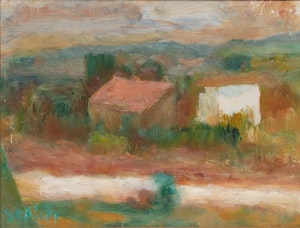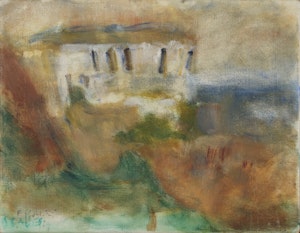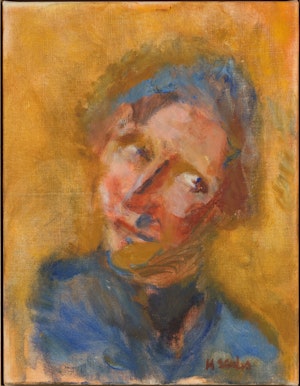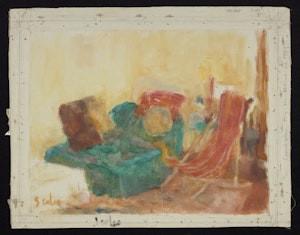Date
16 December, 1975
— 11 January, 1976
Venue
Auckland City Art Gallery
Location
Auckland, New Zealand
In 1974 Colin McCahon, inspired by the discovery that Flora Scales had returned to live in New Zealand, conceived a plan to mount an exhibition of her work at the Auckland City Art Gallery (under Director Ernest Smith) over the summer of 1975-1976. A large cast of friends and colleagues were called upon to help bring this plan to fruition. Eventually Brenda Gamble, Programme Secretary at the Gallery, became the curator as well as being responsible for the social side of the event.
Colin McCahon correspondence with Ron O’Reilly, 27 September 1974, marks the beginning of McCahon’s search for Flora Scales, “Did I tell you Flora Scales lives on our end of Dominion Rd[?] Barry Lett foxed her out…Scales I have no address –“ - Simpson, Peter, Dear Colin, Dear Ron, Te Papa Press, Wellington, 2024, pg 398
Continues, 21 October, “(Scales lives at our end of Dominion Road. Is painting & could be visited.)” - Simpson, Peter, Dear Colin, Dear Ron, Te Papa Press, Wellington, 2024, pg 401
Continues, 13 November, “I'm being handed the Flora Scales exhibition by the Art Gallery. I've just come home from a most interesting morning with Ernest Smith & Anne Kirker & Miss Scales. Smith has put $300 on all the work. Flora has come up with a great heap of drawings from the Hoffman [sic for Hofmann] period. It's all taking shape. I will have to produce a catalogue & will need help from you & Luit & Toss. The whole show will be small & the catalogue small also. But I want it to be accurate – it's about time – …To let you know the latest Scales. I want to buy for Hocken too. Do I buy for you at $300?” - Simpson, Peter, Dear Colin, Dear Ron, Te Papa Press, Wellington, 2024, pg 401.
On McCahon’s suggestion O’Reilly purchases House and Plum Trees [BC070].
Correspondence Toss Woollaston to Colin McCahon, headed “RD3 Motueka”, 19 November 1974, “I learnt much more than I could learn at once. It seeped in gradually for years after – no doubt changed a little by my assimilation…I do remember being told one should sit above the level of a landscape, on a hillside: that lines diverging outward, correspond to our sense of space increasing as you get further away whereas converging lines pinch space unpleasantly…” - E.H. McCormick Research Library, Auckland Art Gallery Toi o Tāmaki, New Zealand, ref. file SCALES, H.F.V. (Flora) CORRESPONDENCE (Private) 4, pp 2, 4
This letter from Woollaston to McCahon was in reply to McCahon’s request for Woollaston's recollection of Flora Scales’s guiding remarks about painting when they met in 1934. McCahon was preparing to curate the 1975-76 exhibition Helen F.V. Scales at the Auckland City Art Gallery.
Colin McCahon correspondence with Ron O’Reilly, undated [marked received 30 November 1974], “Am now just surfacing again & on about Chère Flora. I hear from Peter McLeavey that the $300 is stupid. [footnote, “…McLeavey presumably thought $300 too low a price”] We may up the price. The whole collection is at the moment just sitting – but the news has spread all around & everybody knows. Prices are rising. It's all bloody awful & really a big untruth. I have asked Brenda Gamble to do the very necessary essay for the catalogue. She is so kind & nice – and not so involved as I might be. I will do the paintings & all the small things, Brenda the story…Later. Suddenly Flora was standing in our room and off to Dunedin. We had a good afternoon at the Art Gallery & she handed over all the paintings [,] one left here for me. Brenda has heaps of notes. As I expected she & Flora got on wonderfully. There is no Dunedin address. This was one of the most unexpected afternoons I've met with.” - Simpson, Peter, Dear Colin, Dear Ron, Te Papa Press, Wellington, 2024, pg 401-402
Continues, 11 December, “I’m not doing a letter. I’m making notes. 1) Flora [Scales] told me she had received your $300 and had sent some of it back to you. I know nothing more about this lot. 2) Brenda [Gamble] & Flora got on so well & so much happened Brenda has just heaps of information we could never get. Do you think, as I do, that you should write an essay on Scales & Woollaston[?] Very brief. I don't want to stir up too much too soon.” - Simpson Peter, Dear Colin, Dear Ron, Te Papa Press, Wellington, 2024, pg 402
Correspondence Flora Scales to Brenda Gamble, 19 September 1975, “It is very good of you to suggest an opening ceremony and I hope you will not think me ungrateful if I do not fall in with the idea. I will go to post now. Once more with many thanks. Yours sincerely, Helen F V Scales”
Brenda Gamble to Flora Scales, 24 September, “No we do not think you ungrateful in the least for not wanting an opening ceremony for your exhibition – we just thought we would ask in case you liked the idea. Perhaps we can have a cup of tea with you here on whichever day you would like to come in.”
Scales played very little part in the organisation of the exhibition, apparently content to leave it in the enthusiastic hands of McCahon and his team. She did not have an opening celebration or give lectures or explanatory talks to promote her work. Possibly she thought, as the artist, she had completed her part in the venture. Also, as the following letter shows, she felt physically unable to take on anything extraneous to her painting.
Flora Scales to Brenda Gamble, 04 June 1975, “Thank you for your letter asking me to come and see the way you and your collaborators have arranged [the paintings] for exhibition and the catalogue. I am sure they would be very well placed and have faith that you would do it to make the most of them – but I understand how you feel about it – I have been laid up for a week and do not feel fit enough to come in tomorrow. I hope you will excuse me? I am touched at your kindness in ordering a car for me…”
However, Scales did make one firmly expressed intervention, Brenda Gamble to Toss Woollaston, 25 June, “Last Thursday, by invitation, Miss Scales came in to confirm the dating and some of the titles of her paintings. I read to her my introduction [to the catalogue] in case I had made any mistakes in the notes I had scribbled down when she was here in February and asked for clarification of one or two things. She maintained very strongly that she did not want you mentioned in the catalogue. What she added was “What I told Mr Woollaston and what he later made of it is nothing to do with me.”
An unusual aspect of the exhibition was that the paintings were for sale under the management of McCahon. The exhibition travelled to the Govett-Brewster Art Gallery, New Plymouth, 5 March - 15 April (Director Ron O'Reily); Sarjeant Gallery, Whanganui, 17 May - 7 June (Director Gordon Brown); and Peter McLeavey Gallery, Wellington, 5 July - 19 July. By the end of its tour, in Wellington, nineteen paintings had been sold priced at either $150 or $300 with a commission of 33.3% charged in the case of the McLeavey Gallery.
Scales welcomed the income as a means to fulfil her own dream of returning to Europe and buying a car for use as a mobile studio. Sadly, the last part of this plan did not come to pass.
In hindsight, it is clear that McCahon’s innovative exhibition, honouring her life work, was the catalyst for the ensuing rise in interest and recognition of Scales’s work. The acknowledgement was a fitting gift from the younger artist.
Credit: Unless otherwise stated, correspondence quoted regarding this exhibition is held in the E. H. McCormick Research Library, Auckland Art Gallery Toi o Tāmaki, New Zealand, ref. Scales, H F V., Artist File 2A
Foreword by Colin McCahon, Helen F. V. Scales exhibition catalogue:
Kim Wright and Barry Lett discovered Miss Scales working in Auckland a year or so ago. She is still painting.
We hope this exhibition will tell people of a lifetime of painting, from her sometimes didactic early work to the poetry of her plum trees [BC071-BC075, BC077] and the portraits [BC065, BC066, BC120].
The beauty of her vision comes from her thinking about painting and from the grace and care she gives to her work. Without this, how could the plum trees have grown and the portraits become so real?
Some of Miss Scales's paintings were shown informally in a friend's home last year but this is her first one-woman exhibition in a public art gallery. The exhibition has been organised by the Auckland City Art Gallery's Exhibition Department with the additional help of Anne Kirker and Brenda Gamble and the support of the Director, Ernest Smith. I thank all these people and, of course, Miss Scales who made the paintings and who is kindly permitting them to be shown.
- Colin McCahon, Auckland, November 1975
Excerpt from Introduction by Brenda Gamble, Helen F. V. Scales exhibition catalogue:
"Miss Scales is a representative of that breed of intelligent, independent 19th century women who set themselves a goal and attained it, regardless of difficulty or disability, which in her case, was persistently poor health…I met Miss Scales one afternoon in February this year [1975] and asked her if she would tell me some details of her personal life for the purpose of providing notes for this catalogue. Miss Scales, a naturally reserved and charming woman, was very kind and patiently answered all my questions. When asked to comment on her preferences in contemporary painting she said she liked “modern pictures" but would not elaborate on any specific paintings she had seen because she said, "I never criticise young painters I have so many faults myself". A remark very much in character."
Letter to Ron O'Reilly from Toss Woollaston, Motueka, New Zealand, 15 July 1976, “Dear Ron, I have at last seen the Flora Scales show – at Peter's [Peter McLeavey Gallery, Wellington, New Zealand]. I enjoyed it very much…All those little pictures, getting so big and strong (most of them) while you look. So feelingly painted, while so theoretical, too…It made me wonder why after all we paint such big pictures these days, if all that can be done with small ones…” - Toss Woollaston: A Life in Letters, ed. Jill Trevelyan, Te Papa Press, Wellington, 2004, pg 385
Woollaston's closing observation here seems to echo that of Hans Hofmann in 1931, forty-four years earlier, when he wrote, “The small picture format might be much more living, much more leavening, stirring and awakening than square yards of wall space.” - ‘On the Aims of Art’ by Hans Hofmann in Dickey, Tina, Color Creates Light: Studies with Hans Hofmann, Trillistar Books, Canada, 2011, pg 103 (originally published Fortnightly (San Francisco) 1, no. 13, February 26 1932)
Written by Barbi de Lange, 2021
![Untitled [Mousehole Cornwall 3] image](https://florascales.imgix.net/BC030.jpg?ixlib=js-3.8.0&auto=format&w=300)






![Orchard with Plum Tree [3] image](https://florascales.imgix.net/-104-img-BC073-P1060619-Orchard-with-Plum-Tree-colour-change.jpg?ixlib=js-3.8.0&auto=format&w=300)
![Orchard with Plum Tree [4] image](https://florascales.imgix.net/BC077.jpg?ixlib=js-3.8.0&auto=format&w=300)

-Untitled-%5BSelf-Portrait-No-1%5D.JPG?ixlib=js-3.8.0&auto=format&w=300)

![Boarding House, St Ives, Cornwall [1] image](https://florascales.imgix.net/public/-093-img-BC06076-58--BC060-Brd-Hse,.jpg?ixlib=js-3.8.0&auto=format&w=300)
![Untitled [Mousehole Cornwall 2] image](https://florascales.imgix.net/76_65_ad.jpg?ixlib=js-3.8.0&auto=format&w=300)


![Orchard With Plum Tree [2] image](https://florascales.imgix.net/BC072.jpg?ixlib=js-3.8.0&auto=format&w=300)


![Orchard with Plum Tree [1] image](https://florascales.imgix.net/BC071.jpg?ixlib=js-3.8.0&auto=format&w=300)
![Boarding House, St Ives, Cornwall [2] image](https://florascales.imgix.net/-094-BC061-Painting-DSC_6381-1.06.2021.jpg?ixlib=js-3.8.0&auto=format&w=300)


-a.jpg?ixlib=js-3.8.0&auto=format&w=300)
![Greniar [Graniers], St Tropez, Southern France image](https://florascales.imgix.net/public/-047-img-BC024-076-59-Greniar-see-ATL-file.jpg?ixlib=js-3.8.0&auto=format&w=300)

![Still Life, London [1] image](https://florascales.imgix.net/public/-109---BC067---A-262-028.jpg?ixlib=js-3.8.0&auto=format&w=300)
![Still Life, London [2] image](https://florascales.imgix.net/public/-110---BC068---G-341.jpg?ixlib=js-3.8.0&auto=format&w=300)
















